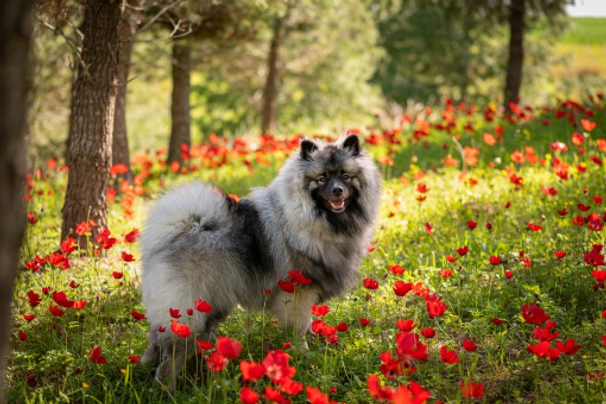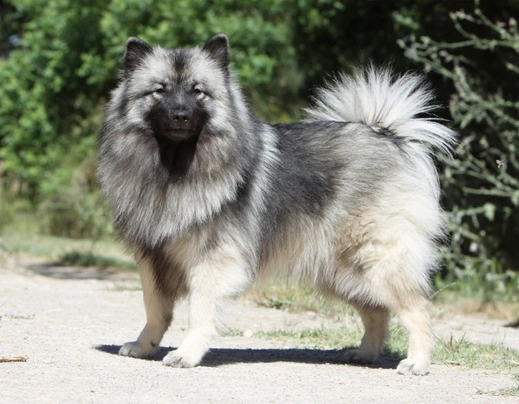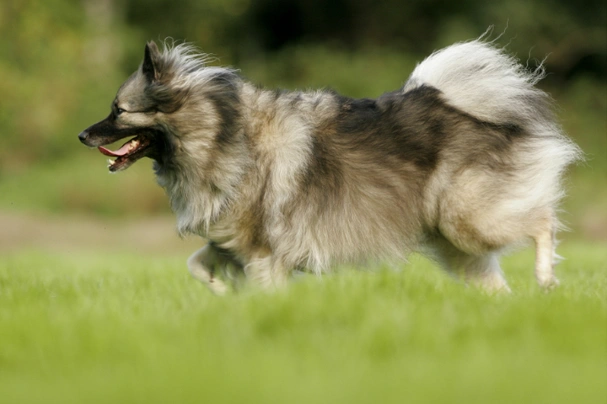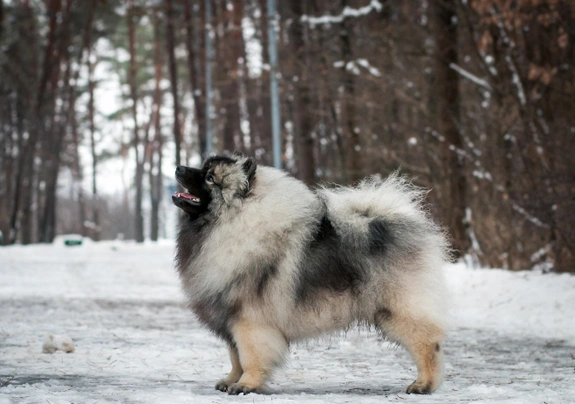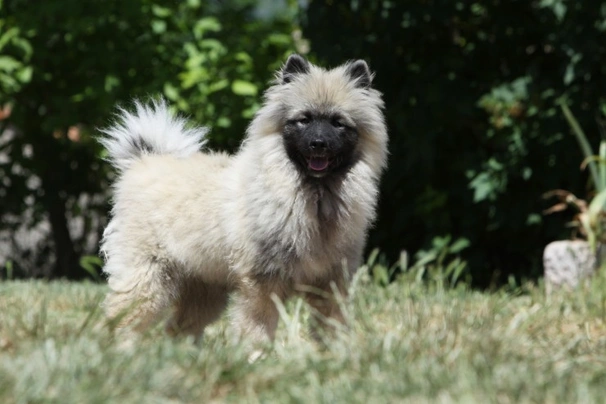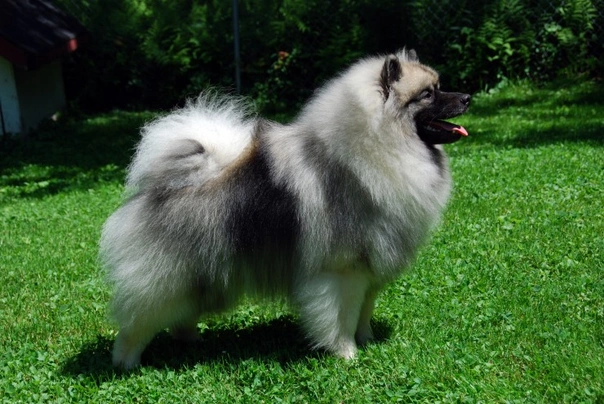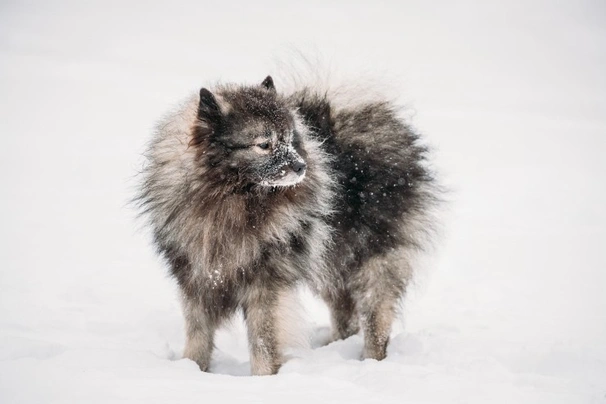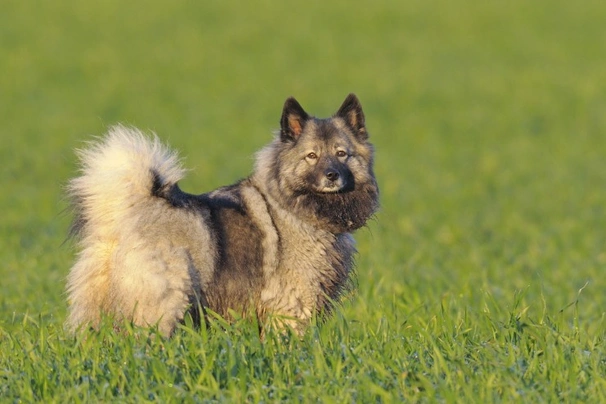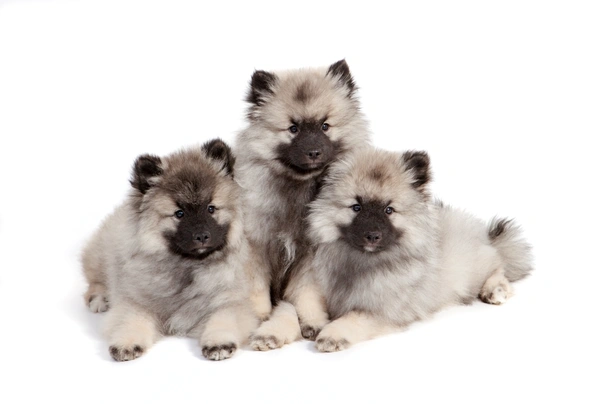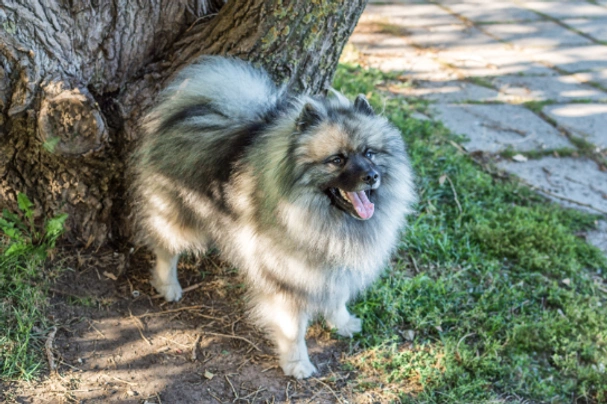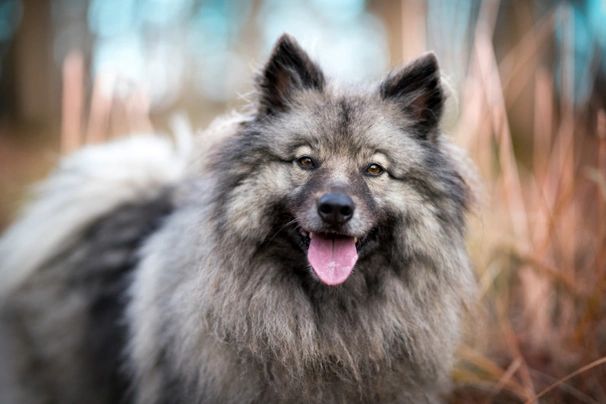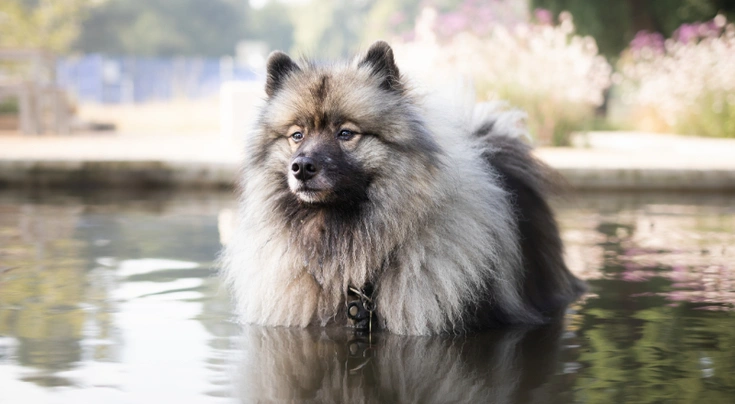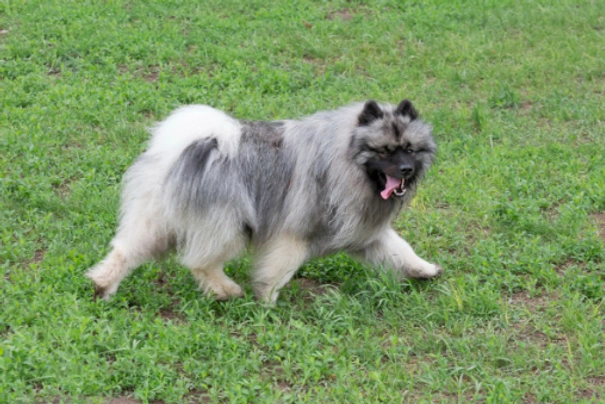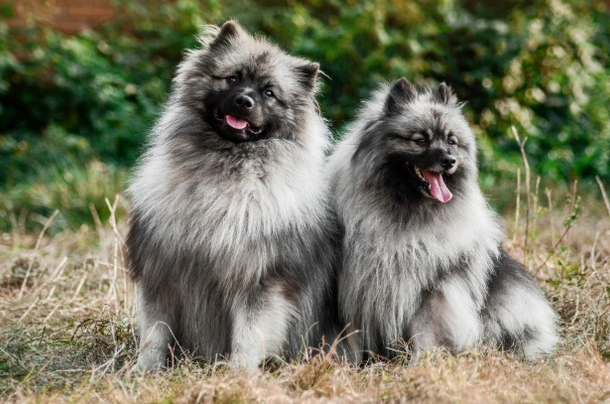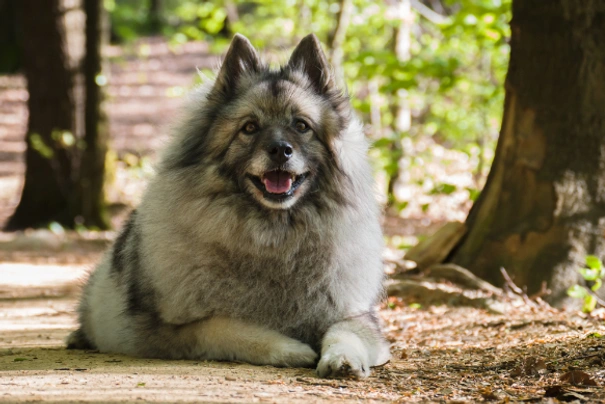Keeshond
Pros
Cons
Introduction of the Keeshond
The Keeshond is often called the "Smiling Dutchman" because of their cheerful expression and natures. Over the years these little dogs have found their way into the hearts and homes of many people thanks to their charming looks and kind loyal dispositions. They are Spitz-type dogs that boast a compact solid appearance and a profuse thick double coat that provides them with excellent protection from the elements.
Like many other of the Spitz breeds the Keeshond is known to be quite vocal by nature which is why they have always been so highly prized as watchdogs on barges farms and in a domestic environment in the Netherlands. Over the years the Keeshond has found a big fanbase in the UK not only because they are so adorable looking but also because they are such devoted family pets and companions too.
History of the Keeshond
The Keeshond is thought to have been developed in the Arctic regions of the world during the 18th century like so many other Spitz-type dogs. There are legends about the breed and how it appeared on Friesland shores when a Viking ship floundered off the coast of Holland. The whole crew drowned apart from the Chieftain’s son and a dog. They were rescued by a fisherman called Christian but their boat was blown off course by the storm and they were driven south before being able to get ashore. To thank his rescuer a chapel was erected which was dedicated to St Olav the patron saint of Mariners. The rescued son’s name was Wolfert and his dog witnessed everything that occurred. This is where the legend ends but the story of the origins of the Keeshond continues in fact.
The fishing village where Wolfert’s rescue boat is supposed to come ashore is the Amstel Rivers flows into the sea and thanks to many storms during the 13th Century the estuary was to become that much bigger so it created the Zuider Zee which meant a dam was constructed across the stretch of water to what was to become Amsterdam where everyone always remembers the story of the little dog and the legend. This led to many sailors believing that to have a dog on board a ship would bring good luck to a voyage and as such it became customary to do so and nobody would rob a ship because of these excellent guard dogs.
With this said throughout time the Keeshond has always been highly prized in their native Holland for being excellent at protecting flocks of livestock and they were often seen being used to hunt down skunks. However they were always bred to be companion dogs rather than to work and quickly found a fan base in Europe more especially in the Netherlands.
The breed was further developed in Holland Germany Italy and France by enthusiasts when they were crossed with German Spitz-type dogs. In the late 1700's Cornelius de Gyselaar became the leader of the Dutch Patriot Party leading the Dutch Patriots against William of Orange. He decided to use his Keeshond as the emblem and mascot of his party. However when the Patriots succumbed to the House of Orange the breed faced near extinction as they were abandoned or destroyed by owners who did not want to be associated with the rebellion.
It took a hundred years for the breed to come to the attention of people again but then World War I broke out followed by the Second World War which seriously impacted breed numbers yet again especially when the German army realised that Keeshonds were being used to carry messages by the resistance which meant as soon as a dog was spotted they were immediately shot.
Thanks to the endeavours of Baroness von Hardenbroek the Keeshond was saved from vanishing forever when she found some dogs and began a breeding programme during the 1920's which was to see breed numbers rise over the ensuing decades. To begin with these charming little dogs were registered with The Kennel Club as the Dutch Barge Dog and the first Keeshond to be exhibited in the show ring was in 1923 after which time their popularity grew throughout the land as well as elsewhere in the world. Today the Keeshond remains a popular choice both as companion dogs and family pets thanks to their charming smiling faces and their kind loyal and affectionate natures.
Interesting facts about the breed
- Is the Keeshond a vulnerable breed? No these little dogs are very popular all over the world including in the UK.
- Amsterdam’s Great Seal depicts an ancient ship with a dog on the deck which is thought to be a Keeshond
- Lady Diana Spencer grew up with a Keeshond in the home her sister Lady Sarah owns one today
- The Keeshond was once known as the Dutch Barge dog
Appearance of the Keeshond
Height at the withers: Males 43 - 46 cm Females 40 - 43 cm
Average weight: Males 15 - 20 kg Females 14 -18 kg
The Keeshond is a charming Spitz-type dog and one that boasts having an extremely plush coat. They are compact little dogs that present themselves very proudly and they always have a smile on their faces which has earned them the nickname of the "Smiling Dutchman". There is quite a noticeable difference between males and their female counterparts with the latter being lighter and smaller in stature.
Their heads are nicely in proportion with the rest of their bodies with dogs having a very slight stop. Muzzles are dark and noses are always black in colour. Their eyes are medium in size and a lovely almond shape being set obliquely on a dog's face. They have a well-defined outline around their eyes which adds to their charming appeal especially as the Keeshond boasts having short expressive eyebrows.
The Keeshond has small dark ears shaped like ivy leaves which they hold upright and which are velvety to the touch. They are set well on a dog's head adding to a dog’s alert look. They have a strong jaw with a perfect scissor bite where their upper teeth neatly overlap their lower ones and their lips are black. Their necks are moderately long and nicely arched being covered in a thick dense hair that forms a ruff around a dog's neck. They have nicely sloping shoulders and straight front legs that show a good amount of bone.
They have short compact bodies with nicely sprung ribs and a good depth to their brisket. Their back legs are well muscled straight with a lot of lighter coloured hair on them which gives the impression of a Keeshond wearing trousers. Their feet are quite cat-like round cream coloured and well-padded with dogs having strong black nails. Their tails are moderately long and set high with dogs curling them tightly over their backs in a double curl.
When it comes to their coat the Keeshond boasts having a harsh straight thick coat that stands well off the body. They have a profuse ruff around their necks and their front legs have a profuse amount of hair on them and are well feathered. They have a softer dense and lighter coloured undercoat. The accepted breed colours for Kennel Club registration are as follows:
- Grey
- Silver grey
- Silver grey and black
It is worth noting that the accepted breed colours for Kennel Club registration can differ from those set out in the breed standard which are as follows:
- A mix of grey and black with dogs having a very pale undercoat that’s either cream or grey but never tawny
The breed standard states that all shades of grey are acceptable with body hairs having black tips. A dog’s shoulder markings must be well-defined with all markings being striking. Pencilling is acceptable and a dog’s forelegs and their hocks must be cream without any black found below their wrists or hocks.
Gait/movement
When a Keeshond moves they do so with a brisk clean sharp and straight gait covering a lot of ground in a determined say when they do.
Faults
The Kennel Club frowns on any exaggerations or departures from the breed standard and would judge the faults on how much they affect a dog's overall health and wellbeing as well as their ability to perform.
Males should have both testicles fully descended into their scrotums and it is worth noting that a dog can be a little lighter or heavier as well as slightly taller or shorter than set out in the Kennel Club breed standard which is only given as a guideline**.**
Temperament of the Keeshond
The Keeshond is known to be extremely people-oriented and they form strong bonds with their owners and families. The downside to this is they don't like to be left on their own for any great length of time which could result in a dog developing separation anxiety. They are fun-loving bouncy dogs that enjoy being included in everything that goes on in a household. The added bonus being they are known to be good around children dogs and other animals although care must be taken when they meet smaller pets which includes rabbits and guinea pigs to name but two animals commonly kept by children.
They are often referred to as the "Smiling Dutchman" thanks to the fact they always have a happy smiling expression on their faces. They have a tendency to bark at the slightest thing which can be a problem for anyone who has neighbours living close by. With this said they make excellent watchdogs and are always quick to let an owner know when there are strangers about. They are a great choice for first time owners thanks to the fact that these clever dogs are easy to train. However because of their thick lush coats owners need to be aware that Keeshonds can really suffer in hotter weather which could result in them overheating and this could prove fatal.
Are they a good choice for first time owners?
Keeshonds are the perfect choice for first time dog owners because they are so amenable and people-oriented loving nothing more than to please and to entertain their families. They are particularly good with young children and older people too although playtime can get a bit boisterous at times.
What about prey drive?
The Keeshonds are very social by nature and don’t generally have a very high prey drive. However this is not to say that a dog would not give chase to a smaller animal when the mood takes them and this includes squirrels and the cat from next door whenever they get the chance.
What about playfulness?
Keeshonds are known to have a very playful side to their natures and love to entertain and be entertained. They are known to be a little mischievous when the mood takes them and being so clever they quickly learn how to please an owner to get their own way.
What about adaptability?
Keeshonds are highly adaptable dogs and providing they are given enough daily physical exercise combined with as much mental stimulation to prevent boredom from setting in they are just as happy living in an apartment as they would be living in a house bearing in mind that garden fencing must be very secure to keep a Keeshond safely in.
What about separation anxiety?
Although Keeshonds form strong ties with their families they don’t generally suffer from separation anxiety providing they are never left to their own devices for too long that is. They are quite independent by nature and don’t mind spending a little time on their own because of this.
What about excessive barking?
Keeshonds like the sound of their own voices a little too much which is something that needs to be gently nipped in the bud when a dog is still young being careful not to frighten them which could end up making them timid and shy.
Do Keeshonds like water?
Most Keeshonds love swimming and will take to the water whenever they can more especially when the weather is hot. However if anyone who owns a dog that does not like water should never force them to go in because it would just end up scaring them. With this said care should always be taken when walking a Keeshond off the lead anywhere near more dangerous watercourses just in case a dog decides to leap in and then needs rescuing because they cannot get out of the water on their own.
Are Keeshonds good watchdogs?
The Keeshond is a natural watchdog which is a trait that’s deeply embedded in their psyche. As such they do not need to be trained to protect anything because they do this without a second thought. However rarely would a Keeshond show any sort of aggressive behaviour preferring to keep their distance stand their ground and bark.
Intelligence / Trainability of the Keeshond
The Keeshond is an intelligent dog and one that likes to please. As such in the right hands and environment they are easy to train and will pick things up very quickly. However the downside to this is that they are just as quick to pick up any bad habits and why they must be handled with a firm yet gentle hand. In the right hands these clever little dogs excel at all sorts of canine sports which includes activities like agility and obedience trials.
They are never happier than when they know their place in the pack and who they can look to for direction and guidance. If they don't know who the alpha dog is they could quickly take on this role and become wilful and unruly. They respond well to positive reinforcement training but not to any sort of harsh correction or heavier handed training methods which would not bring out the best in these intelligent and sensitive little dogs.
Like all puppies Keeshond puppies are incredibly cute and it is all too easy to spoil them when they first arrive in their new homes. However as soon as a puppy is nicely settled in owners must start out as they mean to go on which means laying down rules and boundaries so they understand what is expected of them. It also helps establish a pecking order and who is alpha dog in a household. The first command a puppy should be taught are as follows:
- Come
- Sit
- Stay
- Heel
- Quiet
- Leave it
- Down
- Bed
Children and other
The Keeshond thrives on human contact and they enjoy being in a family environment. They are gentle and patient around children of all ages. However any interaction between younger children and a dog should always be well supervised by an adult to make sure playtime does not get too boisterous which could end up with someone getting frightened or hurt.
When they are well socialised from a young enough age Keeshonds generally get on with other dogs they meet and if they have grown up with a family cat in the home they usually get on well together. However care must be taken when they are around smaller animals and pets just in case. As such any contact is best avoided.
Health of the Keeshond
The average life expectancy of a Keeshond is between 12 and 14 years when properly cared for and fed an appropriate good quality diet to suit their ages.
Like so many other breeds the Keeshond is known to suffer from a few hereditary health issues which are worth knowing about if you are planning share your home with one of these energetic dogs. The conditions that seem to affect the breed the most include the following:
- Hip Dysplasia – Breeders should have stud dogs hip scored
- Congenital deafness – dogs can be tested through the Animal Health Trust (AHT)
- PHPT - DNA test
- Epilepsy
- Luxating Patella
- Obesity
What about vaccinations?
Keeshond puppies would have been given their initial vaccinations before being sold but it is up to their new owners to make sure they have their follow-up shots in a timely manner with the vaccination schedule for puppies being as follows:
- 10 -12 weeks old bearing in mind that a puppy would not have full protection straight away but would be fully protected 2 weeks after they have had their second vaccination
There has been a lot of discussion about the need for dogs to have boosters. As such it's best to talk to a vet before making a final decision on whether a dog should continue to have annual vaccinations which are known as boosters.
What about spaying and neutering?
A lot of vets these days recommend waiting until dogs are slightly older before spaying and neutering them which means they are more mature before undergoing the procedures. As such they advise neutering males and spaying females when they are between the ages of 6 to 9 months old and sometimes even when a dog is 12 months old.
Other vets recommend spaying and neutering dogs when they are 6 months old but never any earlier unless for medical reasons. With this said many breeds are different and it is always advisable to discuss things with a vet and then follow their advice on when a dog should be spayed or neutered.
What about obesity problems?
Like other breeds some Keeshond gain weight after they have been spayed or neutered and it's important to keep an eye on a dog's waistline just in case they do. If a dog starts to put on weight it's important to adjust their daily calorie intake and to up the amount of exercise they are given. Older dogs too are more prone to gaining weight and again it's essential they be fed and exercised accordingly because obesity can shorten a dog's life by several years. The reason being that it puts a lot of extra strain on a dog's internal organs including the heart which could prove fatal.
What about allergies?
The Keeshond is not known to suffer from allergies by if a problem does flare up it's important for a dog to see a vet sooner rather than later. Allergies can be notoriously hard to clear up and finding the triggers can be challenging. With this said a vet would be able to make a dog with an allergy more comfortable while they try to find out the triggers which could include the following:
- Certain dog foods that contain high levels of cereal and other grain-like fillers
- Airborne pollens
- Dust mites
- Environment
- Flea and tick bites
- Chemicals found in everyday household cleaning products
Participating in health schemes
All responsible Keeshond breeders would ensure that their stud dogs are tested for known hereditary and congenital health issues known to affect the breed by using the following schemes:
- DNA test - Primary Hyperparathyroidism (PHPT)
- Hip scoring through the Animal Health Trust
- BAER test for Congenital deafness through the Animal Health Trust (AHT)
What about breed specific breeding restrictions?
Apart from the standard breeding restrictions for all Kennel Club recognised breeds there are no other breed specific breeding restrictions in place for the Keeshond.
What about Assured Breeder Requirements?
It is mandatory for KC Assured Breeders to use the following test on stud dogs and all other breeders are strongly advised to follow suit:
- DNA test for PHPT
Caring for the Keeshond
As with any other breed Keeshonds need to be groomed on a regular basis to make sure their coats and skin are kept in top condition. They also need to be given regular daily exercise to ensure they remain fit and healthy. On top of this dogs need to be fed good quality food that meets all their nutritional needs throughout their lives.
Caring for a Keeshond puppy
Keeshond puppies are boisterous and full of life which means it's essential for homes and gardens to be puppy-proofed well in advance of their arrival. A responsible breeder would have well socialised their puppies which always leads to more outgoing confident and friendly dogs right from the word go. With this said any puppy is going to feel vulnerable when they leave their mother and littermates which must be taken into account. The longer a puppy can remain with their mother the better although it should never be for too long either.
It's best to pick a puppy up when people are going to be around for the first week or so which is the time needed for a puppy to settle in. Puppy-proofing the home and garden means putting away any tools and other implements that a boisterous puppy might injure themselves on. Electric wires and cables must be put out of their reach because puppies love chewing on things. Toxic plants should be removed from flowerbeds and the home too.
Puppies need to sleep a lot to grow and develop as they should which means setting up a quiet area that's not too out of the way means they can retreat to it when they want to nap and it's important not to disturb them when they are sleeping. It's also a good idea to keep "playtime" nice and calm inside the house and to have a more active "playtime" outside in the garden which means puppies quickly learn to be less boisterous when they are inside.
The documentation a breeder provides for a puppy must have all the details of their worming date and the product used as well as the information relating to their microchip. It is essential for puppies to be wormed again keeping to a schedule which is as follows:
- Puppies should be wormed at 6 months old
- They need to be wormed again when they are 8 months old
- Puppies should be wormed when they are 10 months old
- They need to be wormed when they are 12 months old
Things you'll need for your puppy
There are certain items that new owners need to already have in the home prior to bringing a new puppy home. It's often a good idea to restrict how much space a puppy plays in more especially when you can't keep an eye on what they get up to bearing in mind that puppies are often quite boisterous which means investing in puppy gates or a large enough playpen that allows a puppy the room to express themselves while keeping them safe too. The items needed are therefore as follows:
- Good quality puppy or baby gates to fit on doors
- A good well-made playpen that's large enough for a puppy to play in so they can really express themselves as puppies like to do
- Lots of well-made toys which must include good quality chews suitable for puppies to gnaw on bearing in mind that a puppy will start teething anything from when they are 3 to 8 months old
- Good quality feed and water bowls which ideally should be ceramic rather than plastic or metal
- A grooming glove
- A slicker brush or soft bristle brush
- Dog specific toothpaste and a toothbrush
- Scissors with rounded ends
- Nail clippers
- Puppy shampoo and conditioner which must be specifically formulated for use on dogs
- A well-made dog collar or harness
- A couple of strong dog leads
- A well-made dog bed that's not too small or too big
- A well-made dog crate for use in the car and in the home that's large enough for a puppy to move around in
- Baby blankets to put in your puppy's crate and in their beds for when they want to nap or go to sleep at night
Keeping the noise down
All puppies are sensitive to noise including Keeshond puppies. It's important to keep the noise levels down when a new puppy arrives in the home. TVs and music should not be played too loud which could end up stressing a small puppy out making them withdrawn timid and shy.
Keeping vet appointments
As previously mentioned Keeshond puppies would have been given their first vaccinations by the breeders but they must have their follow up shots which is up to their new owners to organise. The vaccination schedule for puppies is as follows:
- 10 -12 weeks old bearing in mind that a puppy would not have full protection straight away but would only be fully protected 2 weeks after they have had their second vaccination
When it comes to boosters it's best to discuss these with a vet because there is a lot of debate about whether a dog really needs them after a certain time. However if a dog ever needed to go into kennels their vaccinations would need to be fully up to date.
What about older Keeshonds when they reach their senior years?
Older Keeshonds need lots of special care because as they reach their golden years they are more at risk of developing certain health concerns. Physically a dog's muzzle may start to go grey but there will be other noticeable changes too which includes the following:
- Coats become coarser
- A loss of muscle tone
- Dogs can either become overweight or underweight
- They have reduced strength and stamina
- Older dogs have difficulty regulating their body temperature
- They often develop arthritis
- Immune systems do not work as efficiently as they once did which means dogs are more susceptible to infections
- Older dogs change mentally too which means their response time tends to be slower as such they develop the following:
- They respond less to external stimuli due to impaired vision or hearing
- They tend to be a little pickier about their food
- They have a lower pain threshold
- Become intolerant of any change
- Often an older dog can feel disorientated
Living with a Keeshond in their golden years means taking on a few more responsibilities but these are easily managed and should include looking at their diet the amount of exercise they are given how often their dog beds need changing and keeping an eye on the condition of their teeth.
Older Keeshonds need to be fed a good quality diet that meets their needs at this stage of their lives all the while keeping a close eye on a dog's weight. A rough feeding guide for older dogs is as follows bearing in mind they should be fed highly digestible food that does not contain any additives:
- Protein content should be anything from 14 – 21%
- Fat content should be less than 10%
- Fibre content should be less than 4%
- Calcium content should be 0.5 – 0.8%
- Phosphorous content should be 0.4 – 0.7%
- Sodium content should be 0.2 – 0.4%
Older Keeshonds don't need to be given the same amount of daily exercise as a younger dog but they still need the right amount of physical activity to maintain muscle tone and to prevent a dog from putting on too much weight. All dogs need access to fresh clean water and this is especially true of older dogs when they reach their golden years because they are more at risk of developing kidney disorders.
Grooming of the Keeshond
The Keeshond has a medium length coat that's made up of a thick and extremely waterproof outercoat and a denser much softer undercoat. They shed quite heavily throughout the year only more so during the Spring and then again in the Autumn when more frequent brushing is usually necessary to keep on top of things. They need to be brushed at least twice a week to keep things tidy. It’s worth noting that a Keeshond’s adult coat only grows through when dogs are between 18 months to 2 years old.
It's also important to check a dog's ears on a regular basis and to clean them when necessary. If too much wax builds up in a dog's ears it can lead to a painful infection which can be hard to clear up. In short prevention is often easier than cure when it comes to ear infections.
Exercise of the Keeshond
The Keeshond is an intelligent little dog and one that likes to be involved in everything that goes on around them. They need to be given a minimum of 20 to 40 minutes exercise a day and it must include lots of mental stimulation for them to be truly happy well rounded characters. When a Kees gets bored they can quickly develop some unwanted behavioural issues and this includes being very destructive around the home.
A shorter walk in the morning would be fine but a longer more interesting one in the afternoon is a must. These dogs also like to be able to roam around a back garden as often as possible so they can really let off steam. However the fencing must be extremely secure to keep these active high energy dogs in because if they find a weakness in the fence they will soon escape out and get into all sorts of trouble.
With this said puppies should not be over exercised because their joints and bones are still growing. This includes not letting a dog jump up and down from furniture or going up or down the stairs. Too much pressure placed on their joints and spines at an early age could result in a dog developing serious problems later in their lives.
Feeding of the Keeshond
If you get a Kees puppy from a breeder they would give you a feeding schedule and it's important to stick to the same routine feeding the same puppy food to avoid any tummy upsets. You can change a puppy's diet but this needs to be done very gradually always making sure they don't develop any digestive upsets and if they do it's best to put them back on their original diet and to discuss things with the vet before attempting to change it again.
Older dogs are not known to be fussy eaters but this does not mean they can be fed a lower quality diet. It's best to feed a mature dog twice a day once in the morning and then again in the evening making sure it's good quality food that meets all their nutritional requirements. It's also important that dogs be given the right amount of exercise so they burn off any excess calories or they might gain too much weight which can lead to all sorts of health issues. Obesity can shorten a dog's life by several years so it's important to keep an eye on their waistline from the word go.
Feeding guide for a Keeshond puppy
Puppies need to be fed a highly nutritious good quality diet for them to develop and grow as they should. As a rough guide a Keeshond puppy can be fed the following amounts every day making sure their meals are evenly spread out throughout the day and it's best to feed them 3 or 4 times a day:
- 2 months old - 171g to 234g depending on puppy's build
- 3 months old - 203g to 276g depending on puppy's build
- 4 months old - 219g to 295g depending on puppy's build
- 5 months old - 223g to 301g depending on puppy's build
- 6 months old - 223g to 301g depending on puppy's build
- 8 months old - 191g to 264g depending on puppy's build
- 10 months old - 157g to 222g depending on puppy's build
Once a puppy is 12 months old they can be fed adult dog food.
Feeding guide for an adult Keeshond
Once fully mature an adult Keeshond should be fed a good quality diet to ensure their continued good health. As a rough guide an adult dog can be fed the following amounts every day:
- Dogs weighing 14 kg can be fed 177g to 239g depending on activity
- Dogs weighing 15 kg can be fed 167g to 249g depending on activity
- Dogs weighing 18 kg can be fed 207g to 279g depending on activity
- Dogs weighing 20 kg can be fed 233g to 307g depending on activity
Keeshond price
If you are looking to buy a Keeshond you would need to register your interest with breeders and agree to being put on a waiting list because very few puppies are bred and registered with The Kennel Club every year. You would need to pay anything upwards of £700 for a well-bred pedigree puppy.
The cost of insuring a male 3-year-old Keeshond in northern England would be £22.55 a month for basic cover but for a lifetime policy this would set you back £41.74 a month (quote as of July 2016). When insurance companies calculate a pet's premium they factor in several things which includes where you live in the UK a dog's age and whether they have been neutered or spayed among other things.
When it comes to food costs you need to buy the best quality food whether wet or dry making sure it suits the different stages of a dog’s life. This would set you back between £25 - £35 a month. On top of this you need to factor in veterinary costs if you want to share your home with a Keeshond and this includes their initial vaccinations their annual boosters the cost of neutering or spaying a dog when the time is right and their yearly health checks all of which quickly adds up to over £800 a year.
As a rough guide the average cost to keep and care for a Keeshond would be between £60 to £80 a month depending on the level of insurance cover you opt to buy for your dog but this does not include the initial cost of buying a healthy well-bred Kennel Club registered pedigree Keeshond puppy.
Buying advice
When visiting and buying any puppy or dog there are many important things to consider and questions to ask of the breeder/seller. You can read our generic puppy/dog advice here which includes making sure you see the puppy with its mother and to verify that the dog has been wormed and microchipped.
Finding Keeshond puppies is not always easy in the UKs which means that well-bred puppies can often command a lot of money. As such with Keeshonds there is specific advice questions and protocols to follow when buying a puppy which are as follows:
- Beware of online scams and how to avoid them. You may see online and other adverts by scammers showing images of beautiful Keeshondpuppies for sale at very low prices. However the sellers ask buyers for money up front before agreeing to deliver a puppy to a new home. Potential buyers should never buy a puppy unseen and should never pay a deposit or any other money online to a seller. You should always visit the pet at the sellers home to confirm they are genuine and make a note of their address.
- As previously touched upon finding Keeshond puppies can be difficult and they can be expensive. As such some amateur breeders/people breed from a dam far too often so they can make a quick profit without caring for the welfare of the puppies their dam or the breed in general. Under Kennel Club rules a dam can only produce 4 litters and she must be between a certain age to do so. Anyone wishing to buy a Keeshond puppy should think very carefully about who they purchase their puppy from and should always ask to see the relevant paperwork pertaining to a puppy's lineage their vaccinations and their microchipping.
